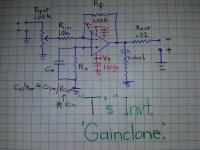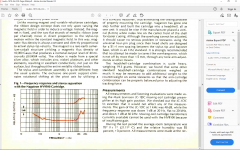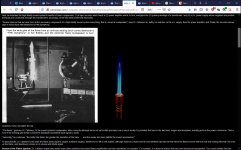Pull a Full Nelson® on that bastige !11!1!
Now that's a good idea: I like the purity and commitment--only ONE type/style/theory of amplification all the way through!
Nice.
IF there's anything to the 'magic' of class A; THEN that would be the way to hear it ...

...oh, oh, ... you could even go Full Nelson® on this and ... and choose a PASS style phono pre precisely and meticulously chosen to work synergistically with your cart (or carts).
Then a pot.
YES!11!1!
Then a PASS style 'amp' that AGAIN is precisely and meticulously chosen to work synergistically with your speaks (or sets).
Hmmmm, mmm, mmm

Simple, elegant, brilliant, synergistic signal filtering, amplifying and current boosting ... mmm, no thanks, I'll PASS! ... And it'll even HEAT yer HOME!1!
😉
[where is pops anyway?!?]
PS 'amp' in quotes because you could do all the gain in the phono pre then just use a power buffer [I recall Pavel had a nice one and then there's that old, what was it, ... Toshiba-based buffer with the inverted PS ... ]
PPS Audio Heaven: Samba Pa Ti on vinyl, thru basic good phono pre, midfi heafty amp, single Paradigm (4ft floorST with the big, white midrange) floorstander in corner ... ahhhhhhh
How about Class A all the way to the speaker VC? Build the speaker with a non-centered VC and biased suspension (like one that's sat horizontally for a few too many years). Use an - of course - adjustable DC current to pull (or push) it back into proper position. Have the audio ride on top of this current.
I can see audiophiles with their calipers now; "Just 1mm off and I can hear the difference".
Now that's a good idea: I like the purity and commitment--only ONE type/style/theory of amplification all the way through!
Nice.
IF there's anything to the 'magic' of class A; THEN that would be the way to hear it ...

...oh, oh, ... you could even go Full Nelson® on this and ... and choose a PASS style phono pre precisely and meticulously chosen to work synergistically with your cart (or carts).
Then a pot.
YES!11!1!
Then a PASS style 'amp' that AGAIN is precisely and meticulously chosen to work synergistically with your speaks (or sets).
Hmmmm, mmm, mmm

Simple, elegant, brilliant, synergistic signal filtering, amplifying and current boosting ... mmm, no thanks, I'll PASS! ... And it'll even HEAT yer HOME!1!
😉
[where is pops anyway?!?]
PS 'amp' in quotes because you could do all the gain in the phono pre then just use a power buffer [I recall Pavel had a nice one and then there's that old, what was it, ... Toshiba-based buffer with the inverted PS ... ]
PPS Audio Heaven: Samba Pa Ti on vinyl, thru basic good phono pre, midfi heafty amp, single Paradigm (4ft floorST with the big, white midrange) floorstander in corner ... ahhhhhhh
Last edited:
try giving your 'opponent' the benifit of the doubt ...
Hey Scott, not sure if you southern neighbours know this but, the rest of most of the world is having a ... a ... you're not gonna believe this, ... a cumbiya moment. Unfortunately, you guys are stuck in an election cycle so ... combative is the way to go ...
But, just fer giggles, let's try this:

..puttin' the DIY BACK into diyaudio... 😉
Hun, so this is a recreation of " "T's" Inverted GainClone ". It obliviously 😉 wasn't his, but rather somebody took his idea of an inverted gainclone power amp and thru a pot on the front ...






 ...
... 
Doh! [1st Task: why is this 'amp' unstable? ]
😉
So I recall T noting (re his power amp) that using an opamp [no matter signal or power] in invert. config. has some advantages.
A) You can choose the values on the +input so they match the -input's (better balance; tweak by actual measurement)
B) Invert. operation provides that nifty virtual ground that, because of the fet input, physically ACTS almost IDEAL [acting purely mathematical with no 'fudge'] and thus that has these tech. advantages ... blah, blah, blah, ... I can't recall what he said.
...oh, oh , and I thought:
C) Well, because [in this particular case] the pot sets the input impedance, Rin and Rf can be dropped by an order of magnitude to provide better noise and more current through the resistors and junction that provides futher benifit by ... blah, blah, blah, I can't recall what I thought. ;}
D)
So I'd like to correct and develop this circuit and build it and do some basic testing and listening and ... and, d o i t m y s e l f , ... if ya know what I mean ...
PS And YES that's how yer supposed to spell n e i g h b o U r s!!11!1!
Amusing snippet from the Boston Audio Society. I consider the bolded comment nonsense.
The Lino C 2.0 uses current-mode amplification, and presents a shortcir-
cuit to the moving-coil cartridge. Atkinson claims it is low-noise. However,
current-mode is an inverting amplifier and exhibits a 3dB noise penalty
compared with conventional voltage amplifiers. The Lino C 2.0 measures
-72.2dBAre500mV, whereas the DB Systems head amp under similar
conditions is spec’d at -80dBA. Also, extreme care must be taken to
ensure connections are tight, as any small impedance in the connections
(even a fraction of an ohm, a nonlinearity that can be caused by oxida-
tion), will cause signal loss and possible distortion.
Hey Scott, not sure if you southern neighbours know this but, the rest of most of the world is having a ... a ... you're not gonna believe this, ... a cumbiya moment. Unfortunately, you guys are stuck in an election cycle so ... combative is the way to go ...
But, just fer giggles, let's try this:

..puttin' the DIY BACK into diyaudio... 😉
Hun, so this is a recreation of " "T's" Inverted GainClone ". It obliviously 😉 wasn't his, but rather somebody took his idea of an inverted gainclone power amp and thru a pot on the front ...






 ...
... 
Doh! [1st Task: why is this 'amp' unstable? ]
😉
So I recall T noting (re his power amp) that using an opamp [no matter signal or power] in invert. config. has some advantages.
A) You can choose the values on the +input so they match the -input's (better balance; tweak by actual measurement)
B) Invert. operation provides that nifty virtual ground that, because of the fet input, physically ACTS almost IDEAL [acting purely mathematical with no 'fudge'] and thus that has these tech. advantages ... blah, blah, blah, ... I can't recall what he said.
...oh, oh , and I thought:
C) Well, because [in this particular case] the pot sets the input impedance, Rin and Rf can be dropped by an order of magnitude to provide better noise and more current through the resistors and junction that provides futher benifit by ... blah, blah, blah, I can't recall what I thought. ;}
D)
So I'd like to correct and develop this circuit and build it and do some basic testing and listening and ... and, d o i t m y s e l f , ... if ya know what I mean ...
PS And YES that's how yer supposed to spell n e i g h b o U r s!!11!1!
Last edited:
Is the 100K pot loaded with a 10K resistor a linear pot? Interesting way to make a sort of audio taper. However pots do not like having current through the wiper. And the -R changes from 9K to around 100K so matching input Z on the opamp is a "moving" challenge. Not to mention the noise penalty of the large resistors. But it may sound good.
Is the 100K pot loaded with a 10K resistor a linear pot? Interesting way to make a sort of audio taper. However pots do not like having current through the wiper. And the -R changes from 9K to around 100K so matching input Z on the opamp is a "moving" challenge. Not to mention the noise penalty of the large resistors. But it may sound good.
Shhh, wait a day or so; so that everyone can see, correct and think of suggestions / development.
And then we'll see if we thought the same thing!?!
I'll post an updated schematic tomorrow, should be fun.
.
.
.
Ok, this is s o r t of a test. Upon returning, I found the vitriol so extreme that I want to see if diyaudio [the BT thread and this one] is, is, is, ... broke. 🙁
Basically, we should all have pretty similar correction, implementation and development for such a simple circuit. IF we don't, ...
.
.
.
..then the egos have landed! and we're all ducked straight to the moon! [that's cheezy, i'm tired...]
In a sentence, if bickering starts then this place ain't what it used to be ...
.
.
.
sigh
.
.
.
... oh, and :
D) At the signal level and with a non-chipamp, you could use a good quality single "opamp" and fully populate the balance (and comp.?) pins, and ... blah, blah, blah ; I can't remember. ;]
E) When you consider the ... blah, ; )
.
.
.
Last edited:
I have compare several amplifier. They reproduce different time at release time in instruments envelope. Some can reproduce longer and some shorter. What cause of it? Different signal to noise ratio? Distortion?
Hope you're living life to the [U]fullest[/U] in these crazy [I]CovidTimes®[/I]
Hey bimo, good to hear from ya, hope you're living life to the fullest in these crazy CovidTimes®!


Hmm, looks like we'll need to unpack that a bit ... it's soooo imprecise it may fall into gobbledygook !!11!1!

"...different time at release time in instruments envelope..."
:hmmm:
Ok, 'release time'; is that the leading edge of a transient, the high frequency component [10k-20kHz]?
If so, then there's a call on line 2 for you from Mr. Fourier.
Fourier transform - Wikipedia ; I love the '...a mathematical transform that decomposes a function..."

"Different signal to noise ratio?"

Hmmm, well the high freq. content of a musical envelope is, by definition SIGNAL, and the noise is DEFINED as NOT signal sooo; ... Where are you going with this?

"Distortion?"
🙂
Well, now we're talkin'! It's always allllllll about the distortion isn't it! 😉

So what type of dist are we talkin' 'boot [ 😉 CAN.] here?!?
1.1 Amplitude distortion
1.2 Harmonic distortion
1.3 Frequency response distortion
1.4 Phase distortion
1.5 Group delay distortion

:0
.
.
.
So, do tell.
Inquiring minds want to know!

Cheers, Jeff

Hey bimo, good to hear from ya, hope you're living life to the fullest in these crazy CovidTimes®!

I have compare several amplifier. They reproduce different time at release time in instruments envelope. Some can reproduce longer and some shorter. What cause of it? Different signal to noise ratio? Distortion?

Hmm, looks like we'll need to unpack that a bit ... it's soooo imprecise it may fall into gobbledygook !!11!1!

"...different time at release time in instruments envelope..."
:hmmm:
Ok, 'release time'; is that the leading edge of a transient, the high frequency component [10k-20kHz]?
If so, then there's a call on line 2 for you from Mr. Fourier.
Fourier transform - Wikipedia ; I love the '...a mathematical transform that decomposes a function..."

"Different signal to noise ratio?"

Hmmm, well the high freq. content of a musical envelope is, by definition SIGNAL, and the noise is DEFINED as NOT signal sooo; ... Where are you going with this?

"Distortion?"
🙂
Well, now we're talkin'! It's always allllllll about the distortion isn't it! 😉

So what type of dist are we talkin' 'boot [ 😉 CAN.] here?!?
1.1 Amplitude distortion
1.2 Harmonic distortion
1.3 Frequency response distortion
1.4 Phase distortion
1.5 Group delay distortion

:0
.
.
.
So, do tell.
Inquiring minds want to know!

Cheers, Jeff

Last edited:
Hello, Jeff. Thanks.
I cant seem to wrap my head around the idea's "efficacy". Perhaps a mechanical bias built into the speaker is the wrong way. Maybe an opposing DC current from an isolated source, to need DC flowing through the speaker wire as a means to offset it. Then you'd have to deal with every possible electrical attribute of a practical isolated DC current source, as it'll for sure have AC properties you can hear. Maybe batteries, but that'd be as practical as those speakers you have to fire up like a torch - gas bottles set behind the cabinets and all...
I originally thought "Blowtorch" referred to a flame-plasma electrostatic speaker! Or preamp for such...
I cant seem to wrap my head around the idea's "efficacy". Perhaps a mechanical bias built into the speaker is the wrong way. Maybe an opposing DC current from an isolated source, to need DC flowing through the speaker wire as a means to offset it. Then you'd have to deal with every possible electrical attribute of a practical isolated DC current source, as it'll for sure have AC properties you can hear. Maybe batteries, but that'd be as practical as those speakers you have to fire up like a torch - gas bottles set behind the cabinets and all...
I originally thought "Blowtorch" referred to a flame-plasma electrostatic speaker! Or preamp for such...
Build the speaker with a non-centered VC and biased suspension (like one that's sat horizontally for a few too many years). Use an - of course - adjustable DC current to pull (or push) it back into proper position. Have the audio ride on top of this current.
I can see audiophiles with their calipers now; "Just 1mm off and I can hear the difference".
Don't laugh, I have applied small amounts of DC to Lowthers to lower the distortion.....

Many years ago there was a loudspeaker made by using two overlapping combs of metal to modulate an oxyacetylene flame. The demo did not go well as they made some cows a few miles away miscarry. Cant remember where I read about that one though.
For digital audio he has eight spare fingers.
... how about 110 fingers and 10 thumbs ...



PS Now that I'm a dad, my horrible ... humour ... has taken on a whole life of it's own, ...
.
.
.
... with a nice detached, a water-access only cottage, opera tickets, ... , even wintering in the 'keys! 😉
Last edited:
T used to use DC to offset drivers and then match that dist. to his SETs, back in'80s
Thorsten Loesch, ex-member, used to use DC to precisely offset drivers and then match that mechanically generated 2nd prominent dist. to his SETs [which had the precisely-matched opposite dist. for almost total cancellation], ... back in the Eastern BLock in the '80s ... Ah the good ol' days!
...hmm, I think you're overthinking things; ... you could go Fuller Nelson! Some of his designes have a small offset that's then blocked by a big electro in parallel with a film. Tweak circuit to correct DC offset and ... Bob's Yer Uncle!
That right there could be the most awesomest thing I've heard in months!
.
.
.
ahem,
John you have a new name tag for the TradeShows® !!11!1!
Flame-Plasma Electrostatic Speaker Engineer!
... no wait ...
JUNIOUR Flame-Plasma Electrostatic Speaker Engineer!
😎
Hello, Jeff. Thanks.
I cant seem to wrap my head around the idea's "efficacy". Perhaps a mechanical bias built into the speaker is the wrong way. Maybe an opposing DC current from an isolated source, to need DC flowing through the speaker wire as a means to offset it. Then you'd have to deal with every possible electrical attribute of a practical isolated DC current source, as it'll for sure have AC properties you can hear. Maybe batteries, but that'd be as practical as those speakers you have to fire up like a torch - gas bottles set behind the cabinets and all...
Thorsten Loesch, ex-member, used to use DC to precisely offset drivers and then match that mechanically generated 2nd prominent dist. to his SETs [which had the precisely-matched opposite dist. for almost total cancellation], ... back in the Eastern BLock in the '80s ... Ah the good ol' days!
...hmm, I think you're overthinking things; ... you could go Fuller Nelson! Some of his designes have a small offset that's then blocked by a big electro in parallel with a film. Tweak circuit to correct DC offset and ... Bob's Yer Uncle!
Hello, Jeff. Thanks.
I originally thought "Blowtorch" referred to a flame-plasma electrostatic speaker! Or preamp for such...
That right there could be the most awesomest thing I've heard in months!
.
.
.
ahem,
John you have a new name tag for the TradeShows® !!11!1!
Flame-Plasma Electrostatic Speaker Engineer!
... no wait ...
JUNIOUR Flame-Plasma Electrostatic Speaker Engineer!
😎
Last edited:
... how about 110 fingers and 10 thumbs ...
PS Now that I'm a dad, my horrible ... humour ... has taken on a whole life of it's own, ...
.
.
.
... with a nice detached, a water-access only cottage, opera tickets, ... , even wintering in the 'keys! 😉
He's all thumbs?
Last edited:
Pics or it didn't happen ...
Pics or it didn't happen ...
Many years ago there was a loudspeaker made by using two overlapping combs of metal to modulate an oxyacetylene flame. The demo did not go well as they made some cows a few miles away miscarry. Cant remember where I read about that one though.
Pics or it didn't happen ...
'Steelmanning' Scott ...
True, but maybe try to give your opponent the benefit of the doubt and think, 'well what might they be hearing/thinking?"
So



Inductors are natural EMC/EMI blockers--they CAN'T pass high freq.



An Inductor's distortion mechanisms should be malleable (Sy could tell us, Mr. Materials!) so they should be minimizable to not-worry-about-it levels



An Inductor is just a ... wire. I can even make loops of those. Git 1 O dos $20 ind. metres off eplay an' 3 diff. gage mgnet wire and ...
...
... In fact, where's mr.customcoil himself?!?! That's it, screw you guys. I'm outta here! :doorslam:



See maybe inductors have a roll in filtering. At least that's how I roll!

PS Note that not using "...MIGHT..." is not exactly what non-pros shouldn't do! ...

Doh!
You're not really high end unless you use inductors rather than capacitors. Where are the equivalent articles to Bateman, etc. outlining the less than ideal behaviors of inductors? Folklore is the force i.e. the high end has become more hopeless than ever, inductors have more non-idealities, distortion, etc. than capacitors ever could have.
True, but maybe try to give your opponent the benefit of the doubt and think, 'well what might they be hearing/thinking?"
So



Inductors are natural EMC/EMI blockers--they CAN'T pass high freq.



An Inductor's distortion mechanisms should be malleable (Sy could tell us, Mr. Materials!) so they should be minimizable to not-worry-about-it levels



An Inductor is just a ... wire. I can even make loops of those. Git 1 O dos $20 ind. metres off eplay an' 3 diff. gage mgnet wire and ...
...
... In fact, where's mr.customcoil himself?!?! That's it, screw you guys. I'm outta here! :doorslam:



See maybe inductors have a roll in filtering. At least that's how I roll!

PS Note that not using "...MIGHT..." is not exactly what non-pros shouldn't do! ...

Doh!
Last edited:
Pics or it didn't happen ...
i think it may have been part of an article in Wireless World quite a few years ago, and it was modulation of the flame volume by opening and closing the gaps in the comb, bit like a hedge trimmer.
more on Transimpedance
Now I know this is only of interest to the sort of person who gets their MCs rewound for lolz but had a chat with my Russian friend who does this sort of stuff and he pointed out something that is obvious but I hadn't fully grasped, and links to Hans comments about the 90:1 impedance difference for a 25:1 voltage difference. As you go lower in impedance the coil resistance drops faster the voltage up to a point as you put fewer turns of fatter wire on. On a recent rewire he said that going from 10 to 9 turns and going up one wire size halved the resistance.
A quick Google suggests around 0.4 Ohms for average tonearm internal wiring (need to confirm that) so 0.5Ohm coils appears to be the point diminishing returns really kick in and 1 Ohm is probably as low as any sane individual would want to go.
Bill
P.S. Disclaimer: I do not believe any of this adds any audible benefit. This is just for fun consenting adults stuff 🙂
Now I know this is only of interest to the sort of person who gets their MCs rewound for lolz but had a chat with my Russian friend who does this sort of stuff and he pointed out something that is obvious but I hadn't fully grasped, and links to Hans comments about the 90:1 impedance difference for a 25:1 voltage difference. As you go lower in impedance the coil resistance drops faster the voltage up to a point as you put fewer turns of fatter wire on. On a recent rewire he said that going from 10 to 9 turns and going up one wire size halved the resistance.
A quick Google suggests around 0.4 Ohms for average tonearm internal wiring (need to confirm that) so 0.5Ohm coils appears to be the point diminishing returns really kick in and 1 Ohm is probably as low as any sane individual would want to go.
Bill
P.S. Disclaimer: I do not believe any of this adds any audible benefit. This is just for fun consenting adults stuff 🙂
- Home
- Member Areas
- The Lounge
- The Black Hole......

 ]%[/wiki]
]%[/wiki]

